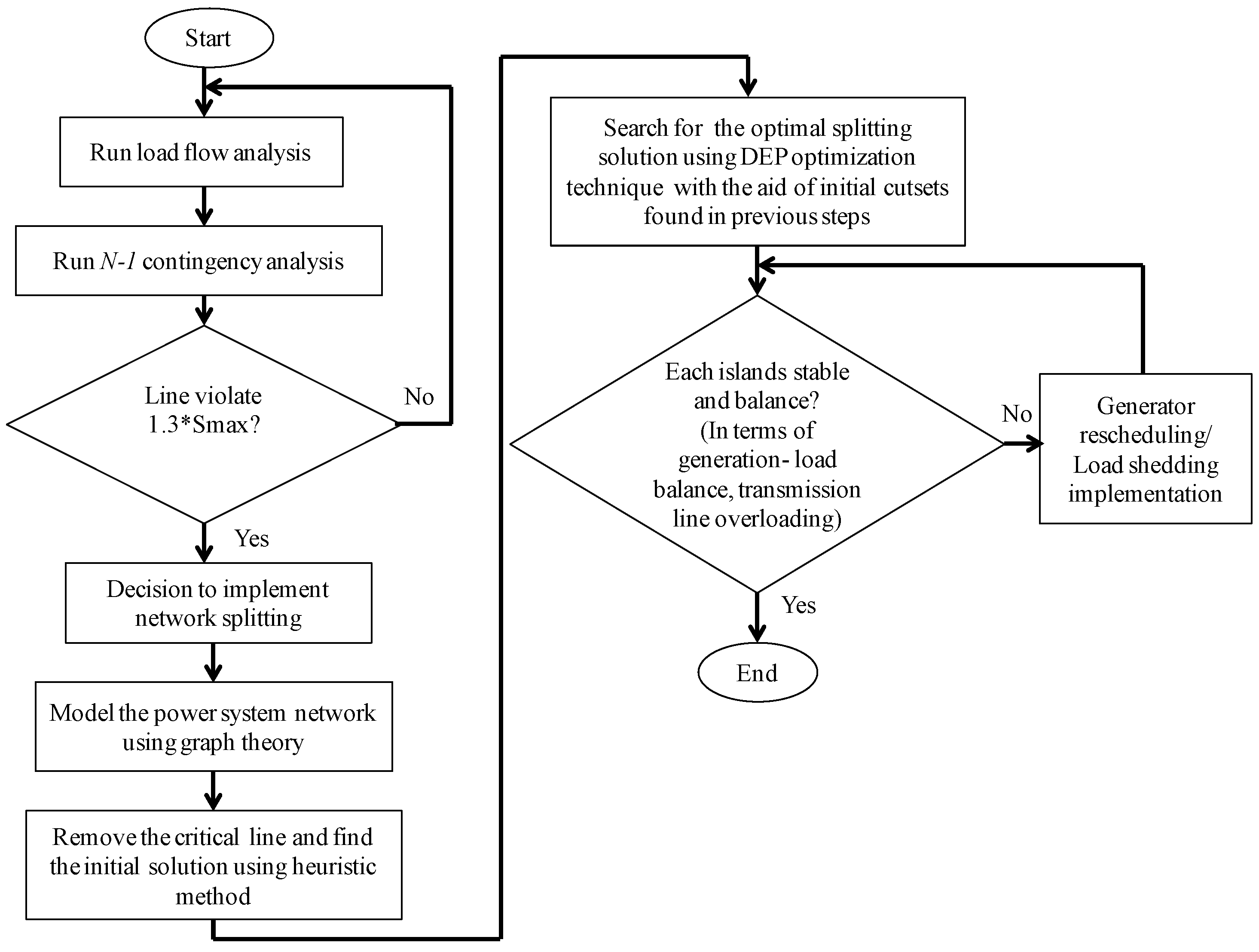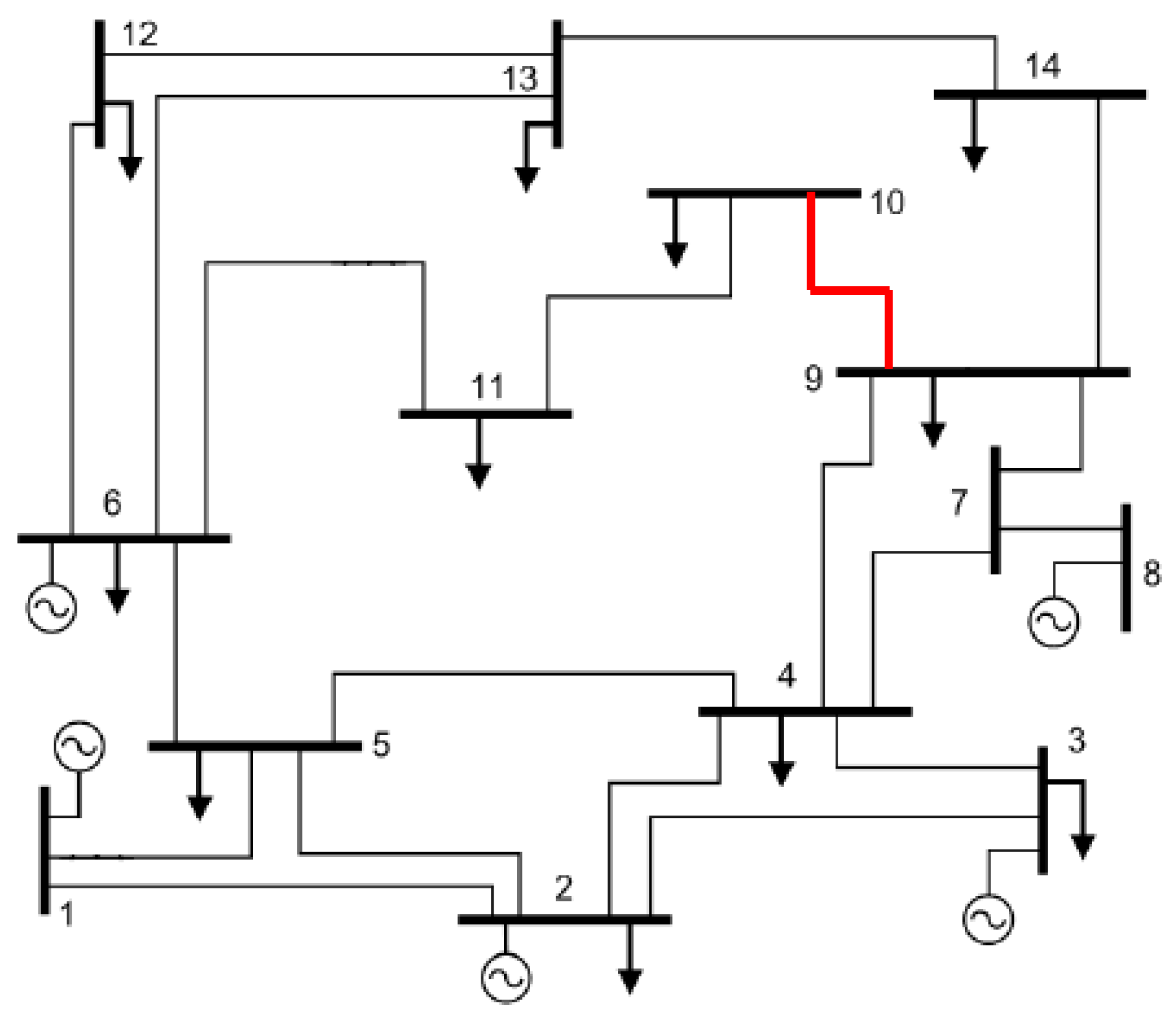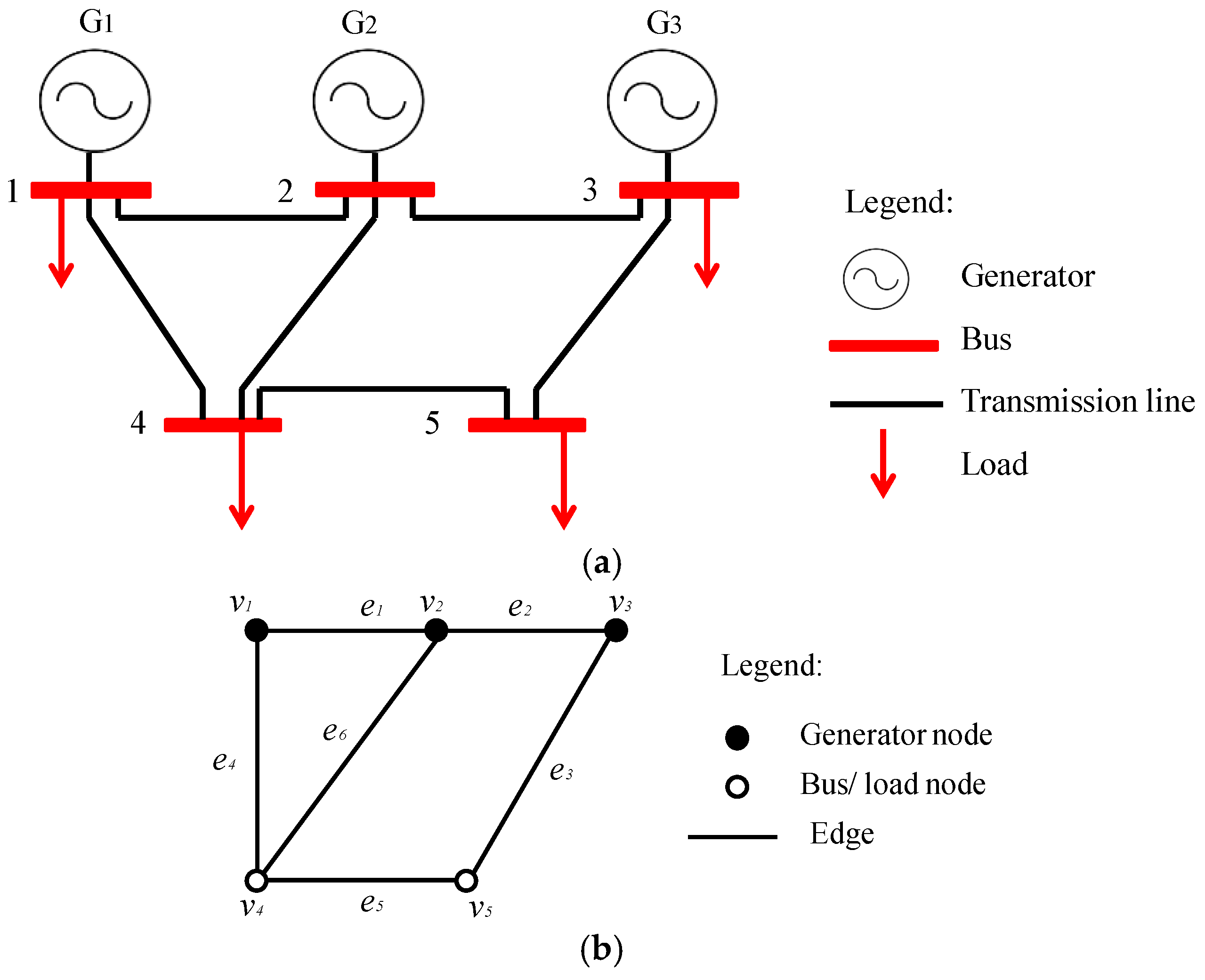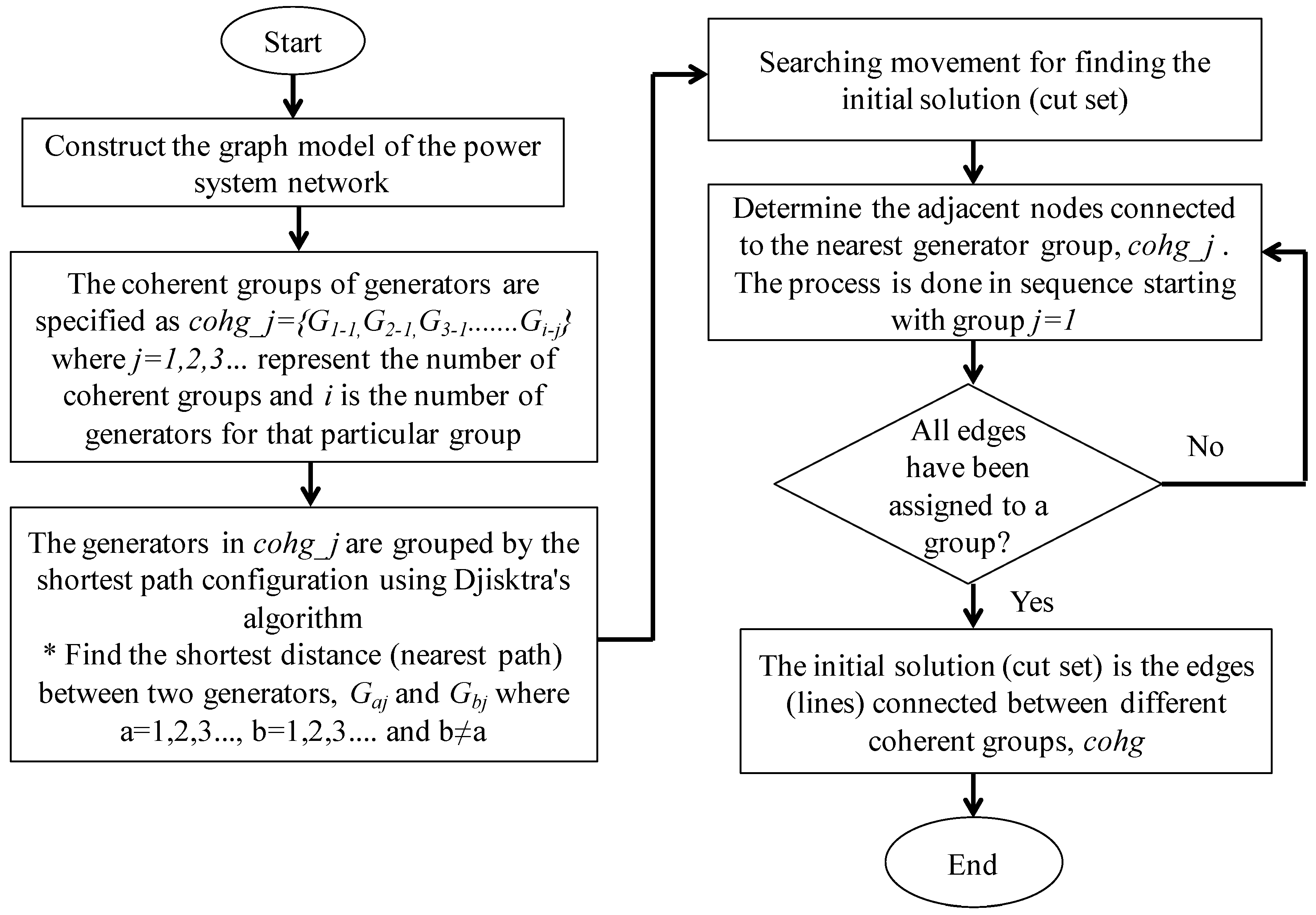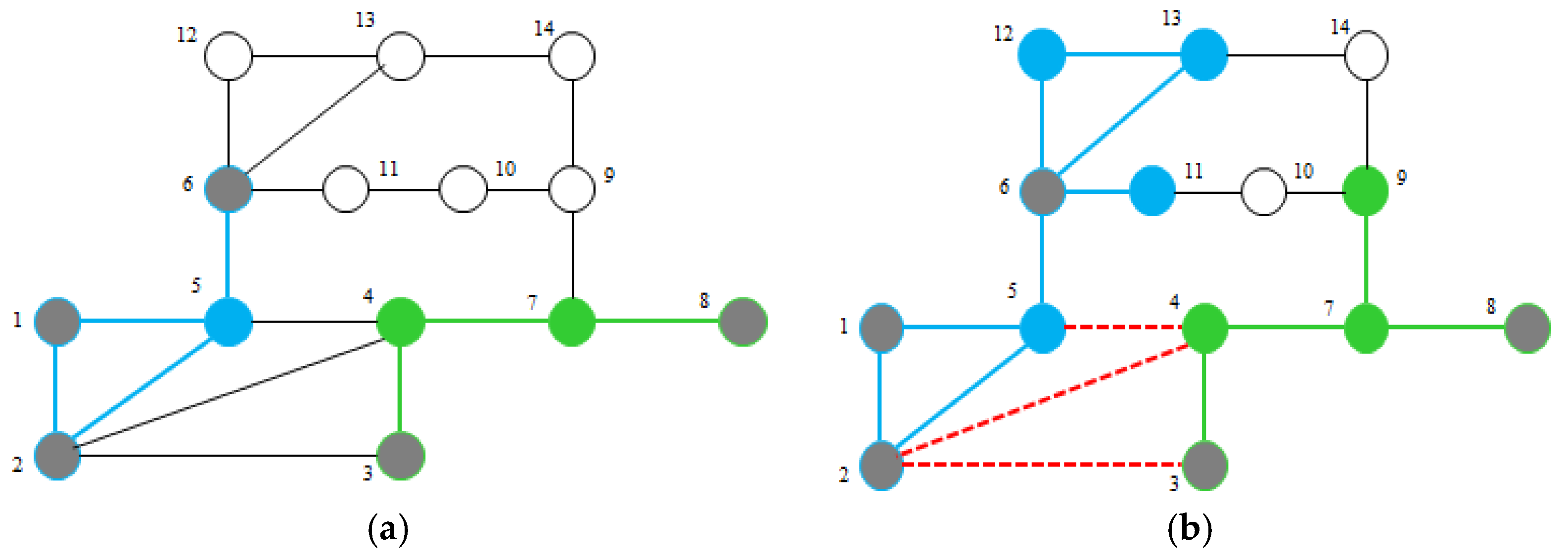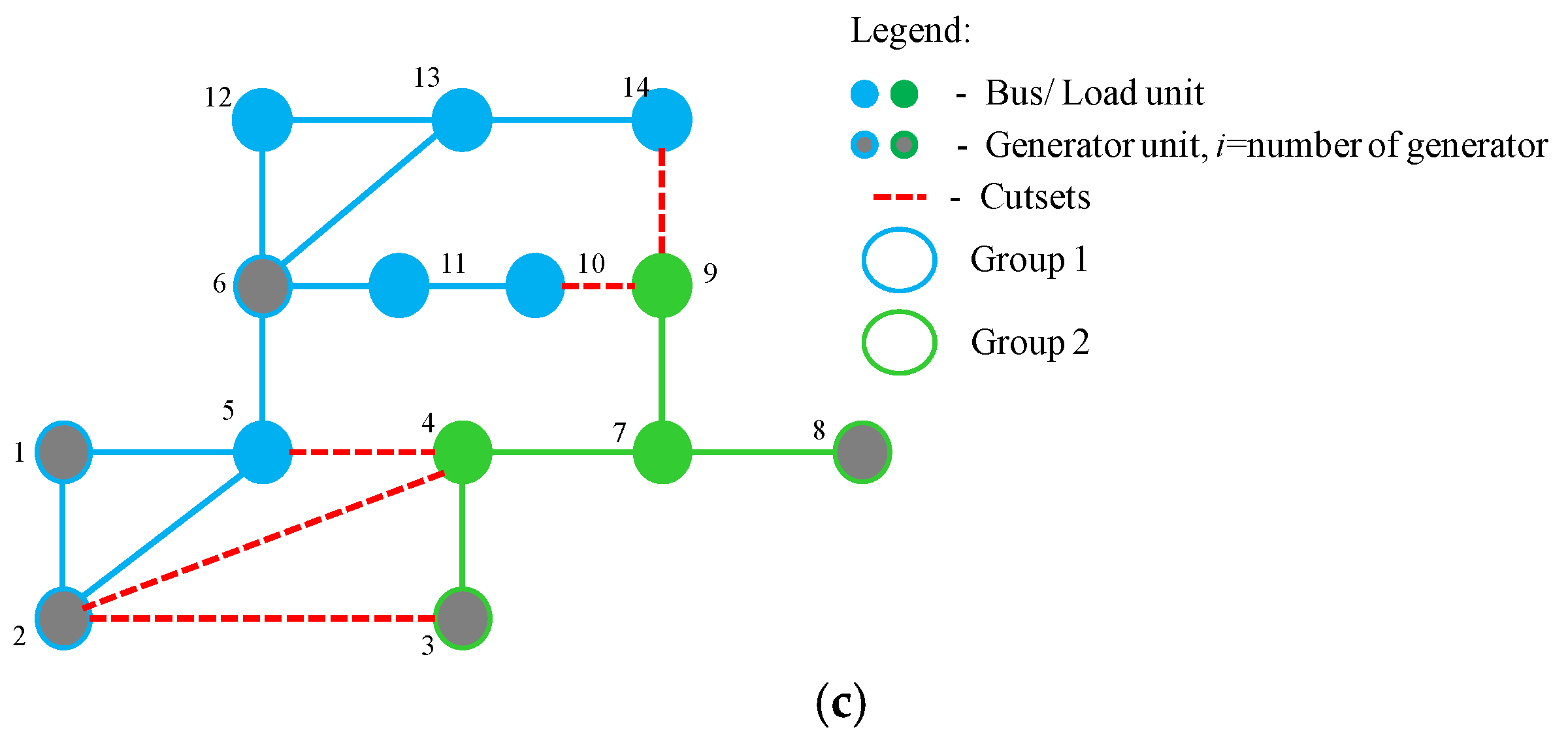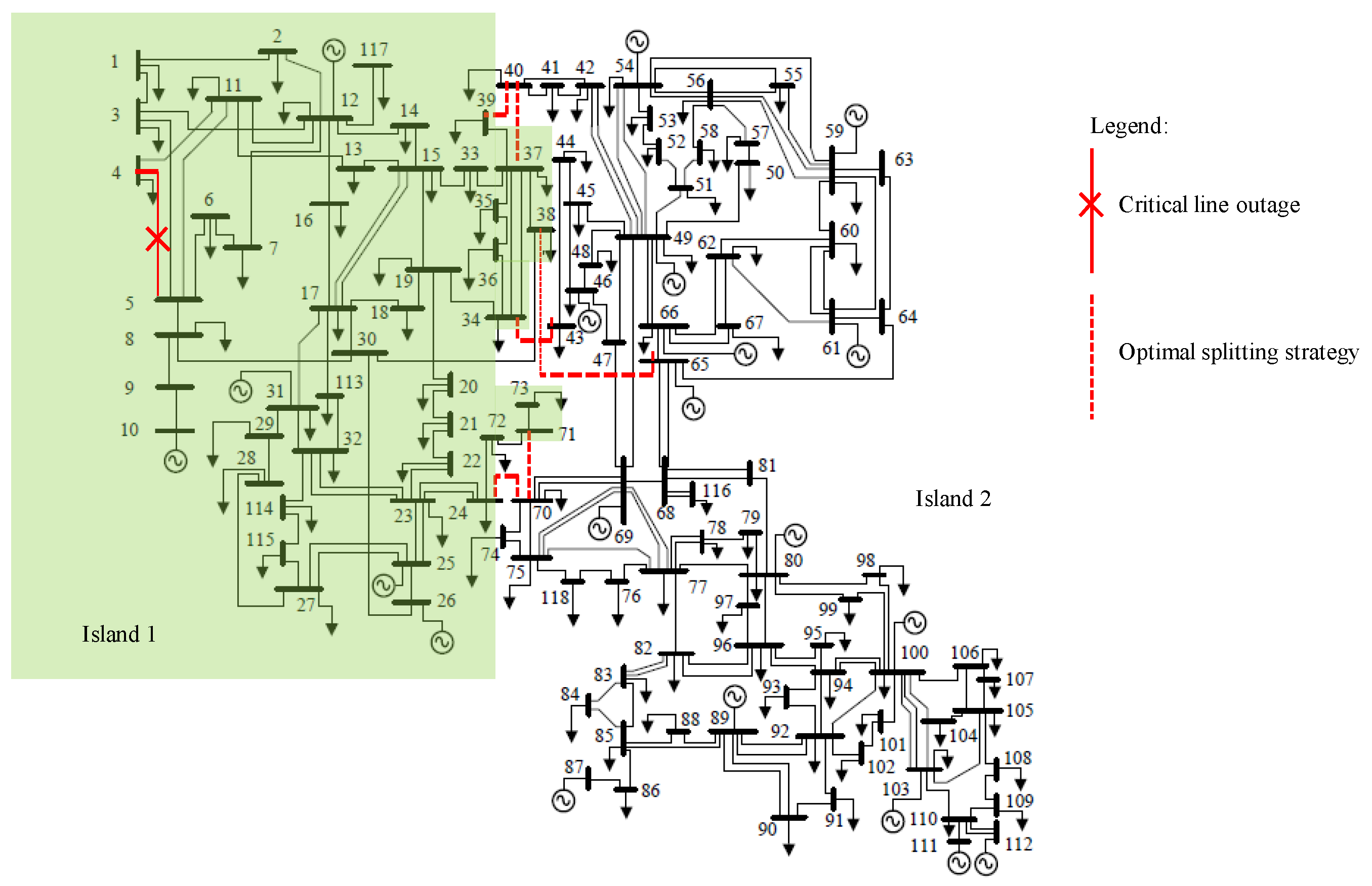A new meta-heuristic approach in determining an optimal network splitting strategy following critical line outages based on
N-1 contingency analysis is presented in this paper. The
N-1 contingency analysis will provide a list of critical lines where, in the event of any failure on the line, serious cascading failures might occur. In this study, a DEP optimization technique is used to find the optimal splitting solution (cutsets) with the aid of initial cutsets obtained through a heuristic approach. A simple and practical load shedding scheme is introduced to ensure reliable island operation when any imbalance between generation and load is detected. The proposed strategy is illustrated in
Figure 1. In general, the strategy is divided into four main steps:
N-1 contingency analysis; network modeling based on graph theory approach; initial cutsets using a heuristic approach; DEP optimization for an optimal network splitting solution. Descriptions and formulations for each step are further presented in the next section.
3.2. Network Representation-Based Graph Theory Approach
In general, a graph
G(V,E) illustrates the relationship between a set of edges,
E, and a set of vertices,
V. A power system network can be represented as a graph model using graph theory. In modeling a power system network, the vertices,
V, represent the major electrical components node (e.g., generators, buses, and load buses) and the edges,
E, depict the transmission lines. An example of graph theory implementation on the IEEE 5-bus system is illustrated in
Figure 3 [
6].
Referring to
Figure 3a, the system contains five buses, three generators, four loads, and five transmission lines. The representation of an IEEE 5-bus system as a graph model is shown in
Figure 3b. The vertices (
v1, v2, v3, v4, and v5) refer to the bus nodes (generator or load) in the network, whereas the edges (
e1, e2, e3, e4, e5 and e6) refer to the transmission lines. The two vertices are said to be adjacent if they are connected by the same edge. The adjacency matrix,
A, can represent the connection of vertex
i to vertex
j, which is described as follows [
21]:
where
n = {1, 2, ..., l
e),
le = the maximum number of edges in a system.
The network splitting strategy (for minimal power flow disruption) proposed in this study uses an undirected graph since the direction of the power flow is not considered; therefore, Aij = Aji = 1 if . As the connection between the buses in the network is described by the adjacency matrix, its use in solving the network splitting strategy is essential.
3.3. Initial Cutsets Using a Heuristic Approach
In this work, suitable initial cutsets that are close to the final optimal splitting solution are computed using the proposed heuristic approach. The proposed heuristic method considers the number of islands and coherent groups of generators during initial cutsets determination. Through the proposed method, the search space of possible lines to be disconnected can be reduced and the convergence process can be accelerated. The first step in implementing the proposed approach is creating the backbone of the network by grouping the coherent generators into particular groups using the shortest path approach. Next, the nearest vertices (line) is assigned to the nearest coherent groups of generators. The line that lies in between the different group of generators is the cutset candidate. The reason for making such a grouping is to ensure the easy coordination of coherent generators in controlling power generation for the loads in the island. Furthermore, this approach will group the coherent generators in the same island, which helps in maintaining the stability of each island after network splitting implementation. The shortest path between the vertices is found based on Djisktra’s algorithm [
22]. The detailed implementation of the approach is presented in
Figure 4.
For a better understanding, the IEEE 14-bus test system is used to illustrate the process of initial cutsets determination using a heuristic approach. In this example, the coherent groups of generators are assigned as
cohg_1 = {1, 2, 6} and
cohg_2 = {3, 8}. An example of backbone formation of the two groups of coherent generators is shown in
Figure 5a, the edges between different coherent groups,
cohg, is the cutset as shown by the dashed line in
Figure 5b, and the cutsets,
CS = {
CS2–3,
CS2–4,
CS4–5,
CS9–10,
CS9–14}, obtained is illustrated in
Figure 5c. The dashed line is the initial cutset for the discrete optimization technique.
3.4. DEP Optimization for Network Splitting Solution
The DEP optimization technique is employed in this work because network splitting is a discrete problem in nature. The number of transmission line to be disconnected during splitting involves integer numbers (e.g., 1–3, 4–6, ..., etc.); thus, a continuous evolutionary programming approach utilizing floating numbers is not suitable in this study.
Figure 6 shows the flowchart for the DEP technique applied in this work.
Referring to
Figure 6, a series of initial populations (parents),
xi, is produced by manipulating the initial cutsets obtained using the heuristic approach explained in
Section 3.3. The original initial cutsets is expended and reduced with a random edge value,
A or
B, from the solution space,
S, as shown in
Table 1. This process is performed based on the possibility that the final optimal solution might have more or fewer lines compared with the initial cutsets. The solution space,
S, is represented by the edges,
E = {
Em}, of the interconnected system where
m = 1, 2, …, total no. of edges.
The constraints considered in the optimization process are the coherent groups of generators and desired numbers of islands.
In this work, the minimal power flow disruption is used as the objective function to find the optimal network splitting strategy, as expressed in Equation (6). The selection of this objective function will produce islands with improved stability [
16].
Pi is the active power flow on the transmission line (i) in the cutsets that form the islands, and nline defines the total number of cutsets (transmission lines to be disconnected). The objective function Equation (6) is calculated for each initial population.
Next, the new populations (offspring),
xi’, are generated by the mutation process on the list of initial populations,
xᵢ. For each candidate in the initial populations, the mutation process is performed by diagonally replacing the edge,
Xi, with a random edge value,
N, from the solution space,
S, as shown in
Table 2. This process helps to generate new offspring that are almost identical to the initial population. Then, the objective function for each offspring (cutsets) is calculated. Equation (6) is used and the constraints stated in the initialization part are utilized in the mutation part as well.
The new populations (offspring) produced will be combined with the initial populations (parents) to enable the best population selection process. In this work, the combined populations are sorted in ascending order according to their calculated objective function (minimal total power disruption, Pdisrup). The 10 best populations, x☐, will be selected as initial populations (parents) for the next iteration. The process of mutating the parents to produce the offspring continues until the maximum iteration is reached. The final list of the 10 best optimal solutions, x☐ will be selected based on the minimal total power disruption, Pdisrup.
3.4.1. Network Reordering
In each step of the process, when the possible splitting solution is found, the network reordering needs to be carried out to enable the load flow analysis to be evaluated. This is based on the fact that, when the system was split, only one island had the slack bus, while the other islands had only PV buses and load. As such, a slack bus should be selected from the existing PV buses. For this study, slack buses are determined based on the PV bus that has the highest power rating capacity. This selection will allow the buses to generate extra power when required.
3.4.2. The Load Shedding Algorithm
There are two significant events that may occur after the implementation of network splitting: excessive power generation and shortage of power generation. In any case, the generation–load equilibrium has to be maintained to ensure the stability in each island.
If the generated power in the island, Pgen, is greater than the load demand, Pload, the network reordering is executed and the generator will adjust accordingly to meet the power balance equilibrium. When load demand (Pload) is greater than the generated power, Pgen, the load shedding algorithm is initiated. The following steps describe the implementation of the load shedding algorithm:
- (a)
The power imbalance,
Pimb, in each island is calculated using Equation (7).
where
Pgen is the generated power in the island, and
Pload is the aggregation of all load and line losses in that particular island.
- (b)
If a power imbalance is noticed in the island where the load demand is more than the total generation, the slack bus is tasked to compensate the generation deficiency. The slack bus can be raised up to its maximum limit of power rating, Pmax(slack). However, after the slack bus power limit is raised to its maximum limit, and there are still power imbalances, then Pimb will be eventually supplied by other generators in the island. The imbalanced amount is divided equally among the generators.
- (c)
A load shedding algorithm will be implemented if a power imbalance is still detected, even if all the generators have reached its maximum limit. In this work, the load shedding scheme is implemented by removing the best combination of loads that correspond to the identified power imbalances.
3.4.3. Transmission Line Overloading Analysis
The transmission line overloading analysis is executed to identify which line has violated its maximum limit,
Pi,max, as expressed by Equation (2). The proposed solution is considered optimal if no lines exceed the permitted limits. However, if the transmission lines violate the maximum allowable limit, then the algorithm will search for the next best splitting solution (refer to
Figure 5).
